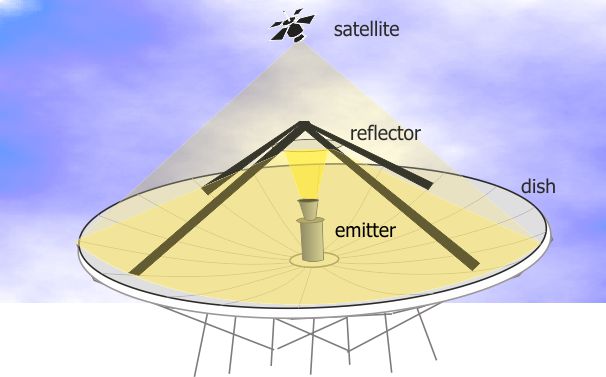Freesat reception - all about dishes
 Brian Butterworth published on UK Free TV
Brian Butterworth published on UK Free TV Satellite reception has both advantages and disadvantages compare with terrestrial (aerial) reception.
By using much higher frequencies (gigahertz, compared to terrestrial televisions megahertz) more transmission channels called transponders (the satellite equivalent of multiplexes) can be provided. For example, there are only six Freeview multiplexes, but Sky or Freesat users can access two hundred satellite transponders.
Aside from exceptional weather conditions (very heavy rain for example) digital satellite provides stable pictures and audio. Where Freeview transmitters are no more than 732 metres above sea level, the geostationary satellites used for television are 35,800,000 metres above the equator so reception is possible even where buildings, trees and hills make terrestrial reception impossible.

The downside of the transmitters being 22,300 miles up in the air is that the signals are very, very weak - so standard TV aerial is of little use. When the signals are sent to the satellites, huge dish transmitters are used to uplink the signal to the satellite. These are tens of metres from side to side, and feature an emitter that generates the signal, which is first bounced of a mirror (called a reflector) and then off the surface of the parabolic dish.

There are many satellites in the sky over the equator. Often these are in clusters over a particular position, for example there are four used for UK television are at 28.2 degrees east. There is another cluster over the 19.2 degrees east positions that are used for German television.
To receive these very weak signals from the satellite, it is necessary to use a dish for reception too. By using a reflective dish, this concentrates the signals onto a small device called a LNB. This is held in front of the dish by a metal arm.

The size of dish for reception is typically much smaller; often 60cm to 100cm in diameter, but the exact size depends upon the transmitting satellite transponder. To keep the transmission power levels down to levels that can be powered by the satellite's solar panels, each beam is focused on a particular area of the Earth's surface. If you are trying to receive the signal at the centre of this zone, a small dish is required. At the outer edges, you may need a 5 metre dish. Maps of these zones are provided by the satellite companies, and are called satellite footprints.
When the dish is installed it must be aligned carefully as the signal is very weak. The installer needs to know the inclination and the azimuth from the ground location to the satellite. If you install yourself you will find that there are markings on the dish that are used to point the dish in the correct position. It is important that the view of the satellite will not be blocked, so must take into account leaves growing on trees and potential building works.
For many people the LNB will have a single cable connected to it, however if you have Sky+ or a multi-room installation the LNB package will actually contain four receivers a quad-LNB. Unlike terrestrial television where you can split the aerial cable to feed more than one Freeview box or television set, with satelite reception you cannot. So, a Sky+ box with two receivers (so you can watch one thing and record another) has two cables connecting the box to the dish.
The cable that connects the dish to the receiver must be satellite grade cable. Whilst this looks superficially like the cable used to connect and aerial to a television, a higher grade cable is required for satellite reception.
Here is an image of a co-axial cable. This sort of cable is used to connect any type of receiving aerial to the reception equipment.

RG6, PF100 and PH100 are all types of coax cable that are suitable for the very weak signals that are received by a satellite dish. (The power is the same as you would receive from a one-bar electric heater on the moon).
The conductor in the centre passes the signals received from the dish to the set-top box. This is made from steel in RG6 cable, and from copper in the RF100 and PH100 types. This makes RG6 less suitable in the UK where rain can damage the cable.
The shielding is responsible for keeping unwanted external interference from damaging the signal. In the cheaper cable this will be a foil wrap, in better specified cables this is a braid (or mesh) of copper wires. The sheild in the RF100 covers 58% of the cable.
The non-conducting layer between the shield and the conductor is called the dielectric. This can be either a solid (RG6), foam (RF100) or air-spaced (PH100) dielectric. This makes the cables progressively more flexible (ie bendy without damage).
simon: LNBs are "universal", there are no special types for HD.
| link to this comment |
7:28 PM
I have a Panasonic TXL32D28 Freesat and Freeview TV. Until recently the freesat has been working perfectly since I purchased the set in March 2011. I am using an existing sky dish left by the previous owner.
Over the last two weeks the TV has increasingly started to pixelate and eventually a "no signal" message shows. I have tried replacing the wire from the LNB to the set and have the same problem. The dish seems secure and there is no visible damage. Can anyone suggest a solution?
| link to this comment |
7:32 PM
Oldham
Capt.Sensible
It is likely to be the freesat box however it is more likely to be the dish alignment.
| link to this comment |
Harry's: mapH's Freeview map terrainH's terrain plot wavesH's frequency data H's Freeview Detailed Coverage
8:21 PM
I've started losing channels on my freesat box, I only get a fraction of the free channels. Recently my signal has deteriorated, really bad interferene and channels randomly disappearing. I cannot pick up any freeview signal at all through my LCD tv with freeview built in.
| link to this comment |
9:13 PM
Dave Dearman: Just as an addition to what Briantist has mentioned insomuch that although a 40cm will still work in Central Scottish areas it should be pointed out that Sky generally uses 54cm dishes North of the Border, this because they provide just that little bit better performance as far as maintaining a stable picture in moderately heavy cloud conditions are concerned.
(Plus of course they are less critical in setting up!).
| link to this comment |
Anne MacDonald: This may be down to the dish having been slightly moved, or it could be down to a failure of the LNB, the device on the end of the arm of the dish.
| link to this comment |
1:37 PM
Hi, I have a 60cm dish pointing to Astra 28.2 freesat with quad LNB, I have Three recievers (foxsat and two technomates), all of them get a strong signal from 28.2 and also a strong signal from Astra 19.2, but only on certain transponders (the ones that get the UK channels). I was hoping to get some german channels. Am I doing somethign wrong or is it that I would need to point directly to 19.2 and then loose the freesat channels
thanks
| link to this comment |
Mike S: You won't get channels from Astra 1 (19.2) unless your dish is pointing at those satellites.
The satellites use the same frequencies, so I expect you are confusing yourself by thinking the channels are coming from Astra 1.
| link to this comment |
5:58 PM
Moray Christie - what decoder are you using ? (50,1.37)
| link to this comment |
10:36 AM
I have had freesat for about 4 years but recently bought two new LED televisions for kitchen and bedroom. I then noticed the picture and sound jumping or skipping frames occasionally. The TV's appear to be working fine and don't do it when I watch a DVD. Could my LNB be failing?
| link to this comment |